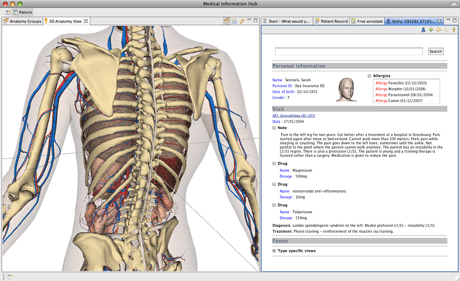
Today, the most comfortable and effective means of handling information is a combination of 3-D graphics, hyperlinks as used in the World Wide Web, and free-text search. Using advanced machine-learning techniques, these approaches are combined in this project initiated at the IBM Zurich Research Laboratory.
The 3-D avatar is a computer-generated figure representing the patient's body. It is easy to display the different parts of the body - the skin, the circulatory system, the skeleton or any of the organs. A mouse click suffices. Medical information about the patient is treated as a personal Web and linked to the avatar via hyperlinks. Textual information about the patient (so-called unstructured data) can be searched and is automatically linked to the patient's graphical representation through use of SNOMED (Systemized NOMenclature of MEDicine), a collection of some 350,000 standardized medical terms.
The system being developed does have an official name, ASME, which stands for Anatomic and Symbolic Mapper Engine. It was first announced in
September of 2007. An informative glimpse of the power of the system can be had through a YouTube video of the system in operation; the URL is given below. Work continues on the development of the system in cooperation with IBM Denmark and a field trial at the Thy-Mors Hospital in northern Denmark.
The purpose of the ASME project is twofold:
- exploring and defining the components of a next-generation browser for electronic medical/health records
- redesigning access to medical information to lower the barrier of IT acceptance in healthcare organizations.
The result is a comfortable, intuitive and inviting interface. One of the lead researchers, Andre Elisseeff, has described the system as "Google Earth for the body."
The general problem of handling medical data is well known and other institutions are also working on solutions. Microsoft, for example, has their "HealthVault" system, available on the Web in beta test. Google also has a system available in beta test, "Google Health." Both the Microsoft and Google systems are intended for the individual or family user to collect and store health information.
The result of the ASME project is making interaction with medical data as simple and as convenient as possible. If, for example, the doctor were to click on the spine, the system would display the available medical history, including text entries, lab results and medical images such as radiographs or MRIs. While the system is already extraordinarily attractive, work continues to make it still better. One idea is to include speech technology to ease record keeping.
I look forward to finding such a device in my doctor's office.
Harry Rudin, Swiss Editor, ERCIM News
Link:
Video: http://www.youtube.com/ watch?v=VAwYdmUd59A
Please contact:
Andre Elisseeff or Ulf Nielsen
IBM Zurich Research Laboratory, Switzerland
Tel: +41 44 724 8686
E-mail: ael![]() zurich.ibm.com or uln
zurich.ibm.com or uln![]() zurich.ibm.com
zurich.ibm.com









